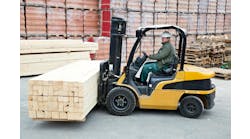There are less-difficult ways to manage a fleet of material handling equipment vehicles than with a pencil and clipboard, a not uncommon practice even in today's highly computerized distribution centers. Turning the job over to a third party, human or computer, is one way to go. Here are three examples of how to tame this critical, laborintensive task.
"Customers don't always know what they need," says Myron Huitt, regional manager, mid-south division, Barloworld (Charlotte, N.C., www.handling.barloworld.com). "But they do know what results they want from their trucks. So we're here to get them out of the lift truck business and back into their core businesses."
Barloworld is a material handling equipment distributor that operates 35 branches in 15 locations, primarily in the Southeast. It is the primary distributor of Hyster lift trucks for this region of the country, says Huitt.
"We begin with an assessment of what the customer already has in place," he says. "When we have all the essential data about its present fleet, we base our recommendation on what the company really needs, not what it has."
Fleet management means more than maintenance
Managing fleet data is sometimes as challenging as controlling the actual trucks. "A common thing we're seeing more of these days," says Huitt, "is companies with multiple locations around the country, yet they want a single bill from a single maintenance supplier, for example."
To resolve this problem, Barloworld established a service center in Atlanta. There it receives all customer calls for service, regardless of the geographic location of the truck. All invoicing when the job is finished, are also funneled through a single point of contact. Customers' wants and needs are becoming more diverse, says Huitt, so a cookie-cutter approach from an equipment distributor will no longer work."Successful fleet management for us," says Huitt, "means being able to adapt to the customer's needs."
When talking with a potential customer, the words Huitt) likes to hear most are, "I want to get out of the forklift business." It means the customer recognizes the truck distributor as the expert, he says. "When the customer stops to analyze the cost of running a fleet of vehicles—payments for maintenance in particular—they quickly see the savings in having a third party run the program," he says.
Technicians formerly assigned to lift truck maintenance can be put to better use as plant maintenance operators. "The other thing that's important," says Huitt, "is that when we establish a contract with a global company that manager, regardless of where he's located, does not have to deal with different maintenance contracts or labor rates."
Since a big issue with lift trucks has always been downtime, in the past companies trying to manage their own fleets simply purchased a couple of extra trucks, just in case. Those days are over, says Huitt. Barloworld offers a guaranteed response time to customers if a truck goes out of service. One challenge for a distributor managing a fleet of vehicles, even when they're the same brand, is that while the customer might be headquartered in Little Rock, its operations will be in areas outside the distributor's territory.
"When that happens," says Huitt, "we work out the arrangements [maintenance contracts] with the Hyster dealer in our customer's area. For the customer it has to be seamless. One call to the service center is all he has to do." The Hyster dealer in the area where the work is done then bills Barloworld for the work.
Real usage data supports better decisions
Sean Bennett, senior financial operations support manager, MBM Food Corporation (Rocky Mount, N.C.) reports that his company was looking for a way to get a handle on the real costs of its fleet of equipment. MBM fulfills customer orders through a nationwide network of 32 distribution centers and a fleet of more than 400 distribution vehicles. It was an early adopter of the InfoLink wireless fleet management system from Crown Equipment Corp.'s (New Bremen, Ohio, www.crown.com).
"Currently we have 92 operators who log into the system," says Bennett. "Its acceptance among employees has been rewarding. They now have ‘ownership' in the pallet jack they're using."
The InfoLink system monitors the use of a lift truck and communicates usage and performance back to a central point. It uses sensors, wireless technology and integrated electronic displays to gather data for alerts to management, along with reports on the condition of the fleet.
"We knew that after we installed InfoLink operators would be careful of how they handled the equipment," explains Bennett. "We left them alone and did not address how the equipment was being handled, establishing a benchmark in that period so we could make a fair assessment."
This assessment tracked a number of areas, including severity and frequency of impacts. After the first 90 days Bennett and other MBM managers began to review the data. What they learned was a surprise. "What we found was that our equipment is being abused more than we thought," he says. "It's a fine example of not knowing what you don't know."
The InfoLink system sends an email alert to floor-level managers when a piece of equipment has been abused. Bennett admits that the severity of impacts was higher than anticipated so they had to modify when sensors would alert managers.
The data MBM has gathered will be used to modify the behavior of the operators, says Bennett. Everyone logging into the system has to be certified regarding which piece of equipment they can operate. "From the time they are certified," says Bennett, "the clock is running on how long before their next certification."
In the past managers at MBM used a rule of thumb to determine the number of lift trucks and pallet jacks it needed to do the job. Now that determination can be based on actual hours in operation information. "What we hope to accomplish is to gather the historical information about the use of equipment to make [purchasing] decisions," says Bennett. When operators log into the system they must run through an OHSA checklist. This gives the employee an opportunity to send a message to managers and the service provider regarding any safety issue.
Managers at MBM have already been able to change the maintenance schedules for equipment based on hard usage data. "Our rule used to be to pull maintenance on equipment once a month," says Bennett. "With actual numbers we've determined that in some cases, once every two months is adequate."
The InfoLink system also allows technicians to send alerts for maintenance directly to operators, which means that he doesn't have to chase that piece of equipment all over the warehouse..
"The system has given us the kind of information we need to make better decisions on managing our fleet," concludes Bennett.
Managing a mixed fleet
Capturing data to a speadsheet and hoping it is the right information may be common practice but its not the best way to manage a mixed fleet of lift trucks, says Mark Cragle, regional manager, BE Fleet (Dallas, www.befleet.com). BE Fleet (which stands for Briggs Equipment) is a Web-based fleet management program that tracks equipment by serial number and uses virtually everything the user can think of to populate a data base.
"We put in things not normally seen like warranty information, lease rates and maximum repair costs of the past," says Cragle. This last item, he says, is helpful to the user because it prevents "sticker shock" when they get a bill for repairs.
The program is a spin-off from a similar program that Briggs Equipment offers for its Yale lift trucks. "We started offering this non-specific equipment program about five years ago," explains Cragle, "and managed to spin off a whole company to manage fleets."
The program offers users three levels of log-ins. "For example, says Cragle, "there is a remote log-in for a manager who needs to see only specific information about the trucks under his immediate control. For the manager who needs the corporate view, we have a different log-in." This would be for the manager who wants to see locations individually or collectively. Then there is the service providers log in to see the specific equipment being maintained, or the maintenance history of a vehicle about to be repaired.
For the end user, the Web-based system offers a seamless way of maintaining and managing the fleet. A link to a designated service provider is created when the manager logs in with a problem. "He just signs in and notifies the system that a unit is down or is operating but needs repair. All he has to do is give a general description of the problem," says Cragle. The manager clicks send and an e-mail alert goes to the service provider. An acknowledgment is returned so the manager can be assured that service people are aware of the problem.
The primary benefit of the program, says Cragle, is to give managers the data they need to make more informed decisions. "Managers recognize that lift trucks take up a lot of their time," says Cragle. "but don't know how to manage the problem. Using a system to gather the right data means they can show how the trucks are used and what it takes to keep them running. They can show the return on investment, important to the people in the front office."
Whether the choice for fleet management is to have a third party do it, or to use a computer-based program, knowing the total cost of ownership helps to maximize asset utilization and determine the value of material handling equipment.


